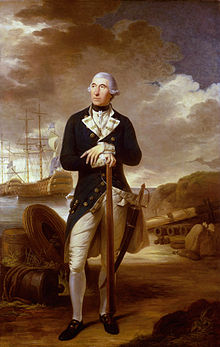
Luc Urbain du Bouëxic, comte de Guichen was a French admiral who commanded the French fleets that fought the British at the First Battle of Ushant (1778) and the Battle of Martinique (1780) during the American War of Independence.

The Battle of Sadras was the first of five largely indecisive naval battles fought between a British fleet and a French fleet off the east coast of India during the Anglo-French War. Fought on 17 February 1782 near present-day Kalpakkam, the battle was tactically indecisive, but the British fleet suffered the most damage. Under Suffren's protection, French troop transports were able to land at Porto Novo, present-day Parangipettai.

HMS Agamemnon was a 64-gun third-rate ship of the line of the British Royal Navy. She saw service in the American Revolutionary War, French Revolutionary, and Napoleonic Wars and fought in many major naval battles. She is remembered as Horatio Nelson's favourite ship, and she was named after the mythical ancient Greek king Agamemnon, the first ship of the Royal Navy to bear the name.
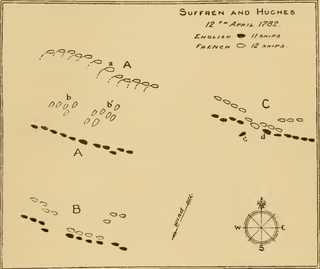
The Battle of Providien was the second in a series of naval battles fought between a British fleet, under Vice-Admiral Sir Edward Hughes, and a French fleet, under the Bailli de Suffren, off the coast of India during the Anglo-French War. The battle was fought on 12 April 1782 off the east coast of Ceylon, near a rocky islet called Providien, south of Trincomalee.
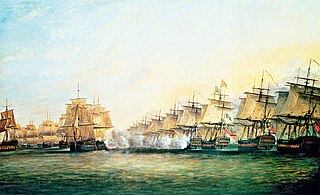
The Battle of Trincomalee was fought between a British fleet under Vice-Admiral Sir Edward Hughes and a French fleet under the Bailli de Suffren off the coast of Trincomalee, then Ceylon, on 3 September 1782. It was the fourth in a series of battles fought between the two fleets off the coast of the Indian subcontinent during the American Revolutionary War.
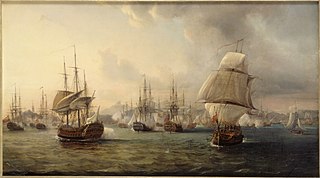
The Battle of Porto Praya was a naval battle that took place during the American Revolutionary War on 16 April 1781 between a British squadron under Commodore George Johnstone and a French squadron under the Bailli de Suffren.

The Battle of Fort Royal was a naval battle fought off Fort Royal, Martinique in the West Indies during the Anglo-French War on 29 April 1781, between fleets of the British Royal Navy and the French Navy. After an engagement lasting four hours, the British squadron under Admiral Samuel Hood broke off and retreated. Admiral de Grasse offered a desultory chase before seeing the French convoys safe to port.

HMS Berwick was a 74-gun Elizabeth-class third rate of the Royal Navy, launched at Portsmouth Dockyard on 18 April 1775, to a design by Sir Thomas Slade. She fought the French at the Battle of Ushant (1778) and the Dutch at the Battle of Dogger Bank (1781). The French captured her in the action of 8 March 1795 during the French Revolutionary Wars and she served with them with some success then and at the start of the Napoleonic Wars until the British recaptured her at the Battle of Trafalgar. Berwick sank shortly thereafter in a storm.
John Elliot was a Scottish officer of the Royal Navy who served during the Seven Years' War and the American War of Independence. He rose to the rank of admiral, and served briefly as colonial governor of Newfoundland.

HMS Latona was a 36-gun, fifth-rate frigate of the Royal Navy that served during the American Revolutionary War, the French Revolutionary Wars, and the Napoleonic Wars. Shortly after her launch in 1781, she participated in the Battle of Dogger Bank against a Dutch squadron in the North Sea. In September 1782, Latona took part in the relief of Gibraltar and was the first ship in the convoy to pass through the Straits, when Richard Howe sent her ahead, to spy on the condition of the Franco-Spanish fleet in Algeciras Bay.
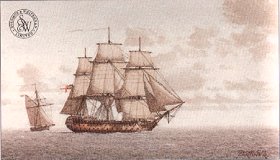
HMS Edgar was a 74-gun third-rate ship of the line of the Royal Navy, that saw service in the American Revolutionary, French Revolutionary and Napoleonic Wars. Launched in 1779, she fought in the battles of Cape St Vincent and Copenhagen, two of the major naval engagements of the wars.

Justin-Bonaventure Morard de Galles was a French navy officer and admiral.
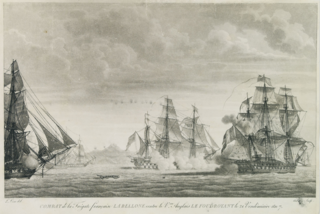
Bellone was an Iphigénie-class 32-gun frigate of the French Navy on plans by Léon-Michel Guignace. She took part in the American Revolutionary War in the Indian Ocean with the squadron under Suffren, and later in the French Revolutionary Wars. She was present at the Glorious First of June.

The Illustre was a 74-gun Magnanime-class ship of the line of the French Navy. She took part in the War of American Independence and in the French Revolutionary Wars. Damaged beyond repairs during the Expédition d'Irlande, she was scuttled on 30 December 1796.

Vice-Admiral Pierre André de Suffren de Saint Tropez, bailli de Suffren was a French naval officer and nobleman. Beginning his career during the War of the Austrian Succession, he briefly served in the Maltese Navy before fighting in the Seven Years' War, where Suffren was taken prisoner by the British at the Battle of Lagos. Promoted to captain in 1772, he served under Charles Henri Hector, Count of Estaing during the naval battles of the American Revolutionary War, taking part in the siege of Savannah in 1779.
Samuel Granston Goodall was an officer of the Royal Navy who saw service during the Seven Years' War, the American War of Independence and the French Revolutionary Wars in a career that spanned 50 years, rising to the rank of Admiral of the White.
The Pourvoyeuse was a 40-gun frigate of the French Navy, lead ship of her class. She is notable as one of the earliest attempts at building a frigate armed with 24-pounders on the artillery deck, rather than the 18-pounders typical of the day.
Saint Michel was a 64-gun ship of the line of the French Navy, lead ship of her class.
HMS Fortune was a British 14-gun sloop launched in 1778 that the French captured in April 1780. She then served with the French navy under the same name.
The action of 12 August 1782 was a minor single-ship action that opposed the French 32-gun frigate Bellone to the British 28-gun HMS Coventry in the run-up to the Battle of Trincomalee. Although both ships were frigates, Bellone belonged to the Iphigénie class and was a comparatively large frigate for her time, carrying a battery of 18-pounder long guns, while Coventry was a sixth-rate armed only with 9-pounder long guns. Furthermore, Bellone had the advantage of the wind. The nominal crew of Coventry was about tho thirds of that of Bellone, but in the occasion it was reinforced by the troops she was carrying. In spite of these overwhelming odds, Coventry managed to inflict heavy casualties on Bellone, and most decisively to shoot most of the senior staff. The resulting confusion on Bellone allowed Coventry to escape to Madras.
